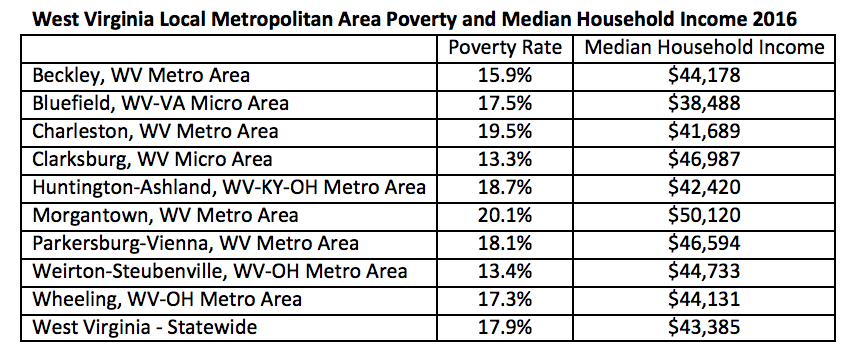For Immediate Release
Media Contact: Caitlin Cook, 304.543.4879
While West Virginia continues to be a national leader in Gross Domestic Product (GDP) growth, the fruits of that growth have not been shared broadly throughout the state. Nearly one-in-five West Virginians live in poverty, and the state has made little progress improving that statistic.
West Virginia’s poverty rate in 2016 was 17.9 percent, and has been stuck at that level for nearly a decade, according to data released today from the U.S. Census Bureau.
The fact that over 319,000 West Virginians lack basic economic security is a drag on the Mountain State’s overall economy and quality of life. Low wages, unaffordable childcare, and the rising costs of higher education are all hurdles to West Virginia families who are struggling to get ahead.
“West Virginia has plenty of options to address this problem. Lawmakers should continue to reject attempts at “tax reform” that do little more than cut taxes for the wealthy, paid for by cutting programs low- and moderate-income families rely on,” said Sean O’Leary, West Virginia Center on Budget and Policy Interim Executive Director. “Instead proven solutions include enacting a State Earned Income Tax Credit, protecting Medicaid, and reinvesting in higher education.”
West Virginia highlights from the 2016 American Community Survey include the following:
- An estimated 319,063 West Virginians lived in poverty in 2016, for a total poverty rate of 17.9 percent. The state’s poverty rate remains statistically unchanged since 2008. West Virginia had the 5th highest poverty rate among the 50 states in 2016.
- West Virginia’s child poverty rate in 2016 was 23.6 percent, with no statistical difference from 2015. An estimated 86,693 children lived in poverty in 2016. West Virginia had the 6th highest child poverty rate among the 50 states in 2016.
- Poverty remains a more serious problem for African Americans in West Virginia. The state’s poverty rate for African Americans was 27.1 percent in 2016.
- Seniors in West Virginia are less likely to be in poverty than the rest of the state. The state’s senior poverty rate in 2016 was 9.5 percent. An estimated 31,883 West Virginians over the age of 65 lived in poverty in 2016.
- Poverty rates decrease for adults with higher levels of education. In 2016, the poverty rate for West Virginians with at least a bachelor’s degree was 4.7 percent, while it was 16.7 percent for those with just a high school diploma. Poverty was highest among those who did not graduate from high school, at 29.7 percent.
- Women in West Virginia face higher poverty rates than men. In 2016, West Virginia’s poverty rate for women was 19.4 percent, compared to 16.4 percent for men.
- Unemployed West Virginians are five times more likely to be living in poverty as employed West Virginians. In 2016 the poverty rate for employed West Virginians was 7.8 percent, while it was 38.8 percent for the unemployed.West Virginia’s median household income was an estimated $43,385 in 2016, $14,232 below the national average. Median household income measures the income of the typical household – or the household in the middle of the income distribution – and serves as a good indicator for how the middle class is faring. West Virginia’s median household income did not increase in the past year, and, adjusting for inflation, has only increased by 1.1 percent since 2007. In 2016, West Virginia had the 2nd lowest median household income among the 50 states.

##